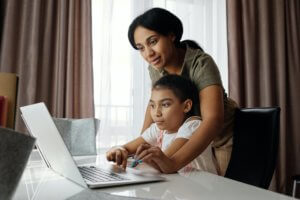
According to Burbio, a firm that monitors school data, more than 2,000 schools were prepared to close for at least one day, due to Covid-19 concerns for the first week of January. There are about 21 states with at least one school district closed or transitioning to remote learning this week. Reuters reports that thousands of U.S. schools have delayed this week’s scheduled return to classrooms, following the holiday break, or switched to remote learning, as the Omicron variant spread.
As 2022 begins, a large number of New Jersey school districts are going virtual to deal with the ongoing spike in Covid-19 cases and the staffing shortages it has caused. The data shows that the vast majority of these are poor, underserved children. This is a disaster for both the children and parents.
According to a new study coauthored by Yale economist Fabrizio Zilibotti, pandemic-related school closures are “deepening educational inequality in the United States by severely impairing the academic progress of children from low-income neighborhoods while having no significantly detrimental effects on students from the county’s richest communities.”
The study also showed that “the consequences of extended school closures for high school students, the researchers determined that children living in the poorest 20% of U.S. neighborhoods will experience the most negative and long-lasting effects of school closures.”
In neighboring New York City, the new mayor, Eric Adams, said that he won’t close down public schools like predecessor Bill de Blasio did, to the consternation of his constituency. Adams said, “The stats are clear. The safest place for children is inside a school. The numbers of transmissions are low. We’re going to create a safe environment with testing.” He added that, “We’re going to identify the children that are exposed. The numbers show the mere fact that a child is exposed in a classroom does not mean that entire classroom is exposed.”
There are some mixed messages from parents. Some are concerned about the health and safety of their children. Others are worried about how they can take care of their kids, while being required to work. Unfortunately, parents throughout the pandemic already know from past experience how incredibly challenging it is to juggle their own work, while simultaneously providing child care and acting as a de facto teacher. The demands are daunting and exhausting.
Working parents bear the brunt of school closures. Their lives are turned upside down. Some parents face a hard choice—keeping a job or taking care of their children. It was reported by the National Women’s Law Center that between August and September, over 800,000 women left the workforce to look after their children.
Single parents, those who have young children and people who—due to the nature of their job—can’t work from home all have an especially high degree of stress, trying to balance all of the necessary demands required in this situation. Low-wage workers at restaurants, food services, warehouses, fulfillment centers and in other businesses don’t have the financial resources to obtain outside help for their children who are now forced to stay at home.
For an uncomfortably large number of families, they rely upon the school lunches to feed their children and lack up-to-date computers, technology and adequate internet connectivity. After a long and strenuous day of working, they now need to find ways to ensure that their kids don’t fall further behind their peers, who possess better equipment, tutors and nannies.
White-collar, dual-working spouses and partners have their own challenges. They need to juggle demanding jobs remotely, while simultaneously providing child care and serving as a teacher.
As the months progress with capricious on-and-off-again school openings, employers could lose their empathy. A manager’s patience may wear thin and might decide to furlough or lay off parents with young children, maintaining that they’re not accomplishing their tasks in a timely manner. Co-workers could become critical of their colleagues with children, believing that they’re carrying the heavy load, as the parents are distracted with homeschooling.
It’s not just the public schools. Universities across the U.S. are going remote for the first few weeks of the semester. New York University announced that a “considerable acceleration” in new Covid-19 cases in the area would effectively shutter its campus before winter break began on December 22. The surge is taking place despite 99% of NYU’s in-person students and full-time faculty members being vaccinated.
School leaders immediately canceled all nonessential gatherings, including parties, sporting events, club meetings and more. Common spaces in dorms, as well as athletic facilities for both students and faculty, are also off limits, while study groups are barred from meeting in person.
Yale University, Duke University, Temple University, the University of Miami and an array of other colleges will be remote for the first two weeks of the semester. A couple of weeks may roll into months or the entire semester. Cornell University is shutting down its Ithaca, New York campus and is moving to “alert level red“—its highest alert level—due to what officials say is a rapid spread of Covid-19 cases among students.
For college students and their parents, the possibility of losing another year of in-class learning is distressing. The young adults complain that online learning is not even close to the classroom experience. Parents are irate over paying up $70,000 in tuition for Zoom classes run by professors who still lack proficiency with the video platforms.
Many of the schools also enact strict mandates that make the students feel alone and isolated. This should be a glorious time in which they enjoy meeting new people, joining clubs, organizations, participating in sports and engaging in extracurricular activities. Instead, the students are locked up in their small dorm rooms all day long. Many will decide to move back home, quit school or slide into depression, due to the unpleasant circumstances.
Source: Forbes


